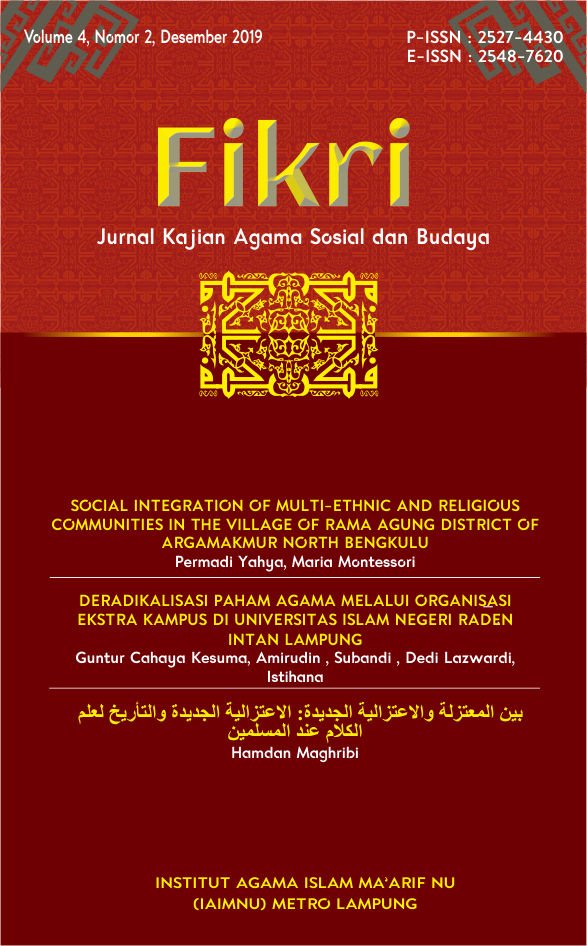PELAKSANAAN PROGRAM INSEMINASI BUATAN BAYI TABUNG MENURUT HUKUM ISLAM DAN HUKUM POSITIF INDONESIA
DOI:
https://doi.org/10.25217/jf.v4i2.558Keywords:
In Vitro Fertilization, Islamic Law, Positive Law of Indonesia, Surrogate MotherAbstract
This paper aims to examine the In Vitro Fertilization (IVF) program in the perspective of Islamic Law, and positive law in Indonesia, so that it is clear whether or not IVF practice is religiously or legally Indonesian. In conducting the analysis, the authors used a qualitative type of library research with a normative approach. The results of this paper are: (1) IVF artificial insemination program is allowed in Islamic Law, with the condition that the sperm must be from the husband himself. In vitro insemination with the uterine rental model Surrogate Mother, there are two opinions. The first opinion states that the Surrogate Mother is prohibited because it creates a mixture of lineage which is also related to mahram and inheritance. The second opinion states that Surrogate Mother was allowed on emergency grounds. (2) The implementation of IVF in Indonesia is regulated in Law Number 36 of 2009 concerning health. The Law stipulates how the requirements and procedures must be fulfilled in order to participate in the program so that the babies made in the program do not violate the ethics in society and religion
References
Anwar, Syamsul. “Fertilisasi in Vitro Dalam Tinjauan Maqāṣid Asy-Syarī‘ah.” Jurnal Al - Ahwal 9 No 2 (n.d.).
Arief, Abdul Salam. Pembaruan Pemikiran Hukum Islam Antara Fakta Dan Realita,. Yogyakarta: Lesfi, 2003.
Bakry, Hasbullah. Pedoman Islam Di Indonesia. Jakarta: UI-Pres, 1988.
Dirckx, John. Kamus Ringkas Kedokteran Stedman Untuk Profesi Kesehatan. 4th ed. Jakarta: Buku Kedokteran EGC, 2004.
Halimah, Mimi. “Pandangan Aksiologi Terhadap Surrogate Mother.” Jurnal Filsafat Indonesia Vol 1 No 1 2018 (2018).
Hamdani, Muhammad Faisal. “Hukum Inseminasi Buatan Dan Bayi Tabung.” Jurnal Al - Ahkam Volume 8 Nomor 1 (March 1, 2010).
Hanafiah Selian, Muhammad Ali. “Surrogate Mother; Tinjauan Hukum Perdata Dan Islam.” Jurnal Yuridis UPN Veteran Jakarta Vol. 4 No. 2 (December 2017).
Handayani, Febri. “Problematika Bayi Tabung Menurut Hukum Islam.” Jurnal Hukum Islam Vol. XIII No. 1 Juni 2013 (June 2013).
Hasan, M. Ali. Masail Fiqhiyah Al-Haditsah Pada Masalah- Masalah Kontemporer Hukum Islam. Jakarta: Grafindo Persada, 1998.
Idris, Muh. “Bayi Tabung Dalam Pandangan Islam.” Jurnal Al - "Adl Vol. 12 No. 1 (January 2019).
Lestari Dewi, Ratna Winahyu. “Aspek Hukum Penyelenggaraan Bayi Tabung Dalam Hukum Positif Indonesia” Volume VI No. 2 2001 (April 2001).
Mahfudh, Sahal. Ahkamul Fuqaha Solusi Hukum Islam, Keputusan Muktamar, Munas Dan Konbes Nahdlatul Ulama (1926-2004 M.). Surabaya: DIantama Surabaya, 2006.
Mariso, James Hokkie. “Analisis Yuridis Tentang Upaya Kehamilan Diluar Cara Alamiah (Inseminasi Buatan) Menurut Undang-Undang Nomor 36 Tahun 2009 Tentang Kesehatan.” Lex Et Societatis, JUrnal Bagian Hukum Dan Masyarakat Fakultas Hukum UNSRAT, Manado VI No. 6 (August 2018).
Mukti, Ali Ghufron, and Adi Heru Sutomo. Abortus, Bayi Tabung, Euthanasia, Transplantasi Ginjal Dan Operasi Kelamin Dalam Tinjauan Medis, Hukum Dan Agama Islam. Yogyakarta: Aditya Media, 1993.
Qardhawi, Yusuf. Fatwa-Fatwa Kontemporer Jilid 3. Jakarta: Gema Insani Pers, 2001.
Rahmawati, Nurul Arifah, and Hirma Susilawati. “Fenomena Surrogate Mother (Ibu Pengganti) Dalam Perspektif Islam Ditinjau Dari Hadis.” Jurnal Nuansa Vol. 14 No. 2 (December 2017).
Rasyid, Hamdan. Fiqh Indonesia: Himpunan Fatwa-Fatwa Aktual. Jakarta: Al - Mawardi Prima, 2003.
Ratman, Deszira. Surrogate Mother Dalam Perspektif Etika Dan Hukum: Bolehkah Sewa Rahim Di Indonesia. Jakarta: Elex Media Komputindo, 2012.
Roswitha Nursanthy, Aji Titin. “Pengaturan Bayi Tabung Ditinjau Dari Aspek Hukum Perdata DI Indonesia.” Jurnal Ilmu Hukum “THE JURIS” STIH AWALONG Samarinda Vol. I, No. 2, Desember 2017 (December 2017).
Salim HS. Bayi Tabung Tinjauan Aspek Hukum. Jakarta: Sinar Grafika, 1993.
Salim, Peter, and Yenny Salim. Kamus Bahasa Indonesia Kontemporer. 3rd ed. Jakarta: Modern English Press, 2002.
Sondakh, Hizkia Rendy. “Apsek Hukum Bayi Tabung Di Indonesia.” Lex Administratum, Jurnal Terbitan Fakultas HUkum UNSRAT III (March 2015).
Sucipto Dwijo, Al Quddus Nofiandri Eko. “Pengembangan IPTEK Dalam Tinjauan Hukum Islam.” JUrnal Pendidikan Agama Islam 2 Nomor 1 (i 2014).
Sumapraja, Sudraji. Penuntun Pasutri Program Melati. Jakarta: Program Melati RSAB “Harapan Kita,” 1990.
Suwito. “Problematika Bayi Tabung Dan Alternatif Penyelesaiannya.” AL-HUKAMA The Indonesian Journal of Islamic Family Law Volume 01, Nomor 02, Desember 2011 (December 2011).
Syaraf, Musha Shalih. Fatwa-Fatwa Kontemporer Tentang Problematika Wanita. Jakarta: Pustaka Firdaus, 1997.
Tahar. Inseminasi Buatan Menurut Hukum Islam. Surabaya: Bina Ilmu, 1987.
Thaha, Ahmadie. Kedokteran Dalam Islam. Surabaya: Bina Ilmu, 1982.
Wibowo, Elisa, Simon Nahak, and Ketut Widia. “Keabsahan Perjanjian Surogasi DI Indonesia.” Jurnal Prasada Vol 4, No 2 September 2017 (September 2, 2017).
Zubaidah, Syarif. “Bayi Tabung, Status Hukum Dan Hubungan Nasabnya Dalam Perspektif Hukum Islam.” Jurnal Al Mawarid VII (July 1999): 45.
Downloads
Published
How to Cite
Issue
Section
License
Authors who publish with this journal agree to the following terms:
- Authors retain copyright and grant the journal right of first publication with the work simultaneously licensed under a Creative Commons Attribution License that allows others to share the work with an acknowledgement of the work's authorship and initial publication in this journal.
- Authors are able to enter into separate, additional contractual arrangements for the non-exclusive distribution of the journal's published version of the work (e.g., post it to an institutional repository or publish it in a book), with an acknowledgement of its initial publication in this journal.
- Authors are permitted and encouraged to post their work online (e.g., in institutional repositories or on their website) prior to and during the submission process, as it can lead to productive exchanges, as well as earlier and greater citation of published work.






